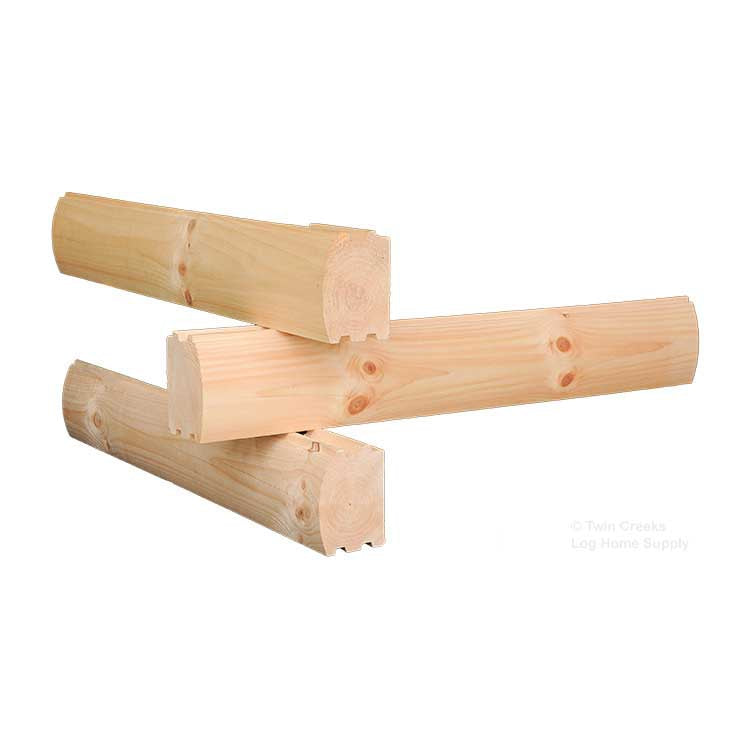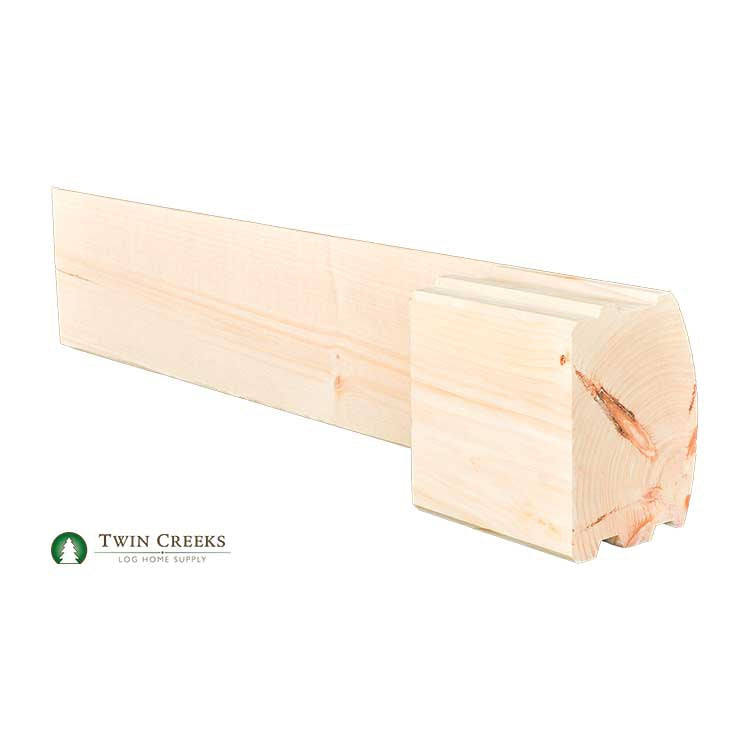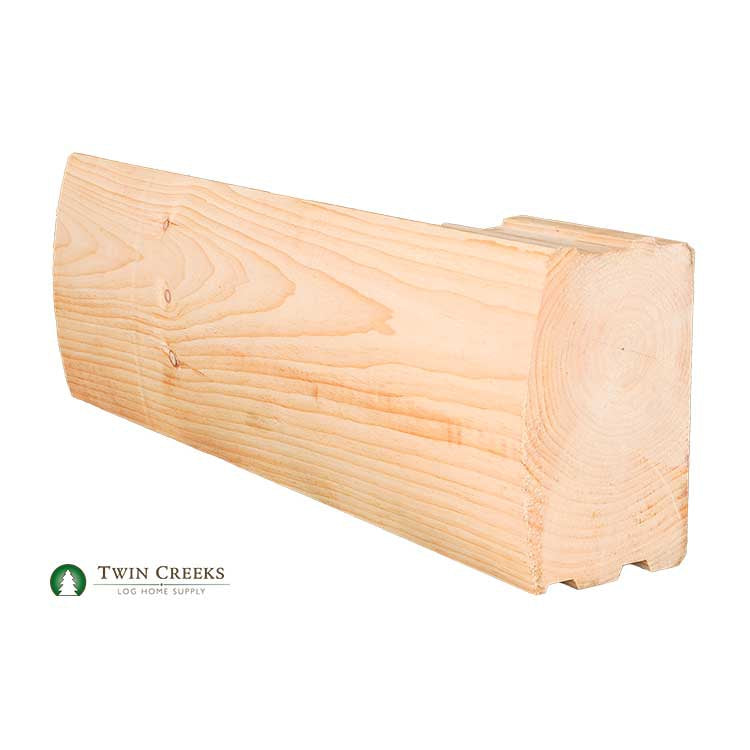White Pine Butt-and-Pass False Corners
Details
White Pine Butt-and-Pass False Corner Specifications:
• Available Lengths: 3' and 4' pieces.
• Typical Lead Time: Please call for an expected lead time as production schedules for this product may vary with seasonality.
• Typical Corner Overhang Length: 8"
• Drying Type: Air Dried.
• Texture: Milled Smooth.
• Fastener Type: Stainless Steel Fastener
• Hewing Options: Draw Knifing is available for this profile for an additional $1.50/lf.
• Shipping Options: Flat-bed tractor trailer, Roll Back, LTL Carrier. Shipping method is determined based on location and order size to minimize cost.
• Additional Products Recommended for Installation: A good quality caulk such as Perma Chink Woodsman Caulk or Weatherall UV Guard Textured Caulk. You can find our selection of caulks at our Caulk page. Before applying a stain, it is also recommended to apply a Borate solution such as Armor Guard to the bare wood before staining to help prevent mold, mildew or termites.
• Details Disclaimer: While we strive to ensure product details are always accurate, product specifications may change and images shown may not represent current dimensions. Please call us if you would like to receive an up-to-date profile drawing.
White Pine Butt-and-Pass False Corner Coverage Calculations:
• Logs or log siding using the Butt-and-Pass corner joinery method need to be installed with all the runs beginning on the same plane.
• You will need 1 corner piece for each run at an outside corner. For example, you will typically have 14 runs of an 8” logs or log siding to reach 8’ eaves. For each outside corner of the house, you would then need 14 false corner pieces.
• Please call us if you would like a free takeoff for your project as well.
Matching Siding Profiles:
6x8 "D" False Corners
• Matching Siding: 2x8 White Pine "D" Log Siding (Deep Profile)
• Stack Height: 7 1/4"
• Log End Width: 5 1/2"
6x12 "D" False Corners
• Matching Siding: 2x12 White Pine "D" Log Siding
• Stack Height: 11 1/4"
• Log End Width: 5 1/2"
Storage Prior To Installation:
Until installed, False Corners need protection from direct sunlight, water saturation, snow, ice, dirt, and other elements. It is best to store the false corners flat and off the ground with a vapor barrier so that moisture is not absorbed through the bottom boards of the stack. The lumber should be protected with a waterproof covering elevated in the center so that water does not pool on the cover. We also recommend that you do not completely seal the bundle, as good air circulation is required to prevent any blue stain or molding. Ideally, the false corners should be stored in an enclosed building such as a garage prior to use.
When installing Butt-and-Pass false corners, it is important to become familiar with the “left” and “right” corner pieces. When looking at the face of the false corner, the left false corner will feature the siding continuing beyond the "log tail" on the left side and the right corner will feature the siding continuing beyond the "log tail" on the right side. After placing the Butt-and-Pass false corners against the wall, your first run of log siding will “butt” up against the back side of your false corner where the false corner will then “pass” the log siding you have installed. This is where the “Butt-and-Pass” name comes from.
1. Fasten the corner to the wall by toe-screwing at both the top of the log tail and the top of the siding portion to ensure a secure fit.
2. Install your first run of log siding by matching it against the end of your false corner siding portion, fastening the first run of siding on both the top and bottom edges of the board.
3. Fasten your first run of log siding on the opposite side of the wall to butt up directly behind the log tail of your false corner.
4. The next false corner will then be placed to match its “groove” with the previous row’s log siding “tongue” crossing over the previous false corner at a 90 degree angle. After the corner is in place, fasten the corner to the wall at the top of both the siding portion, and log tail of the false corner.
5. Fasten your next row of log siding to butt against the back end of the false corner log tail you just installed to complete your second row of corners.
6. Repeat this process until you have reached the eve of your wall and your corner is completed.
• False Corner siding plate should be "staggered" in order to break up the joint line created by matching the log siding against the siding plate. This can be done by trimming the siding plate ends to random lengths or by purchasing varying lengths.
• Log siding is installed as the false corners are installed and each course should be checked that it is level before moving on to the next course.
• When fastening the false corners and log siding, fasteners should be driven flush to ensure a proper fit between the materials.
• False Corners should be sealed on each side (including the ends) with a quality stain to provide proper protection against weathering and decay.
Maintenance:
As with every unfinished exterior wood, applying a quality finish to all surfaces (including the ends) is recommended. An exterior finish protects the wood from moisture absorption and UV degradation, and helps prevent staining caused by mold and mildew. Before applying a finish to the wood, it is best to confirm that there is no mill glaze present on the wood. Mill glaze can inhibit or interfere with the finish treatment and is produced when the material is manufactured through the planer. When mill glaze occurs, it is recommended to remove it by pressure washing the wood or sanding prior to staining. Sanding is not recommended as a first option unless every piece is sanded. We offer a wide selection of Oil and Water Based exterior finishes that we can recommend based on the final finish, maintenance schedule and look that is desired. Most exterior finishes do have to be re-coated or reapplied every 3 -5 years depending on the UV exposure to your home. You can find all of the exterior stain products that we carry at our Exterior Stains page.








